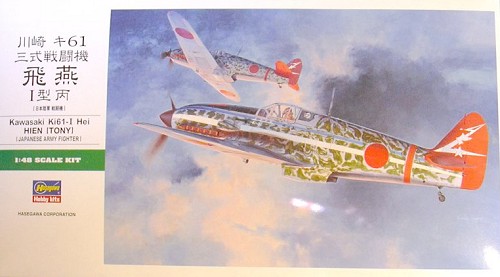
| KIT: | Hasegawa 1/48 Kawasaki Ki-61-I 'Tony' |
| KIT #: | JT 87 (09087) |
| PRICE: | $29.95 MSRP |
| DECALS: | Three options |
| REVIEWER: | Tom Cleaver |
| NOTES: |

| HISTORY |
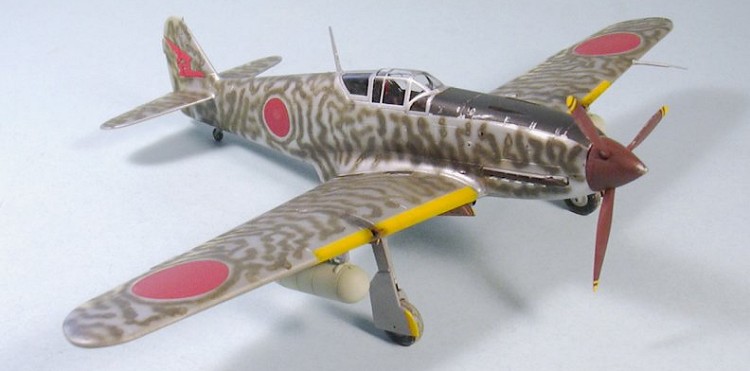
The Japanese Army Air Force was extremely conservative in its view of what constituted a good fighter. As a result, when the JAAF entered the Pacific War, its main fighter was the obsolete (by Western standards) Nakajima Ki.27 (Nate), and its newest fighter ‑ which only equipped one fighter Sentai ‑ was the already‑obsolescent Ki.43 Hayabusa (Oscar). While both fighters were highly‑maneuverable and could give Western opponents fits, an Allied fighter pilot had only to keep his speed up and avoid high‑g "dogfight" maneuvering in the horizontal plane to neutralize the good qualities of either fighter, with the Allied pilot able to break off combat at will through use of superior speed overall, and higher diving speeds, not to mention the fact the Allied fighter could take more punishment from the light armament of the two fighters (two .30 caliber machine guns each) and still get home.
The first JAAF fighter to meet Western standards to enter combat in the Pacific War was the Kawasaki Ki.61, known as the Type 3 Model 1 land‑based interceptor. The Japanese name was Hien, which translates as "Flying Swallow"; the Allied code name was "Tony," due to the fact the first Allied reports of the fighter saw it as a development of either the Bf-109E or the Macchi C.202. First encountered over New Guinea in 1943, the Tony gave agood account of itself through the remainder of the Pacific War, and was considered by its opponents to be one of the most dangerous Japanese fighters, and very difficult to shoot down.
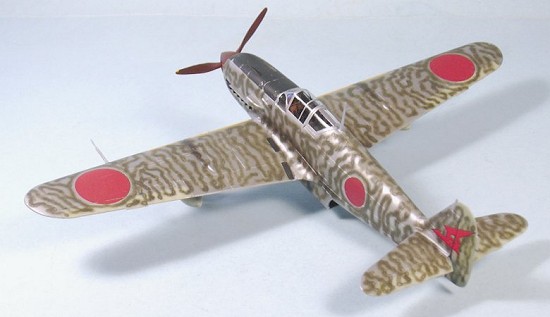 Kawasaki had
acquired the manufacturing rights to the new series of Daimler‑Benz
aircraft engines in 1937, though it would not be until 1940 that the JAAF
would take advantage of this fact. In February 1940, Kawasaki received
development contracts for two fighter designs to be powered by the
Daimler‑Benz DB601A ‑ the Ki.60 and Ki.61. Of the two, the Ki.60 was a
very straightforward attempt to emulate European design standards, with the
result being a "heavy" fighter with a top speed of 350 mph ‑ the fastest of
any JAAF aircraft to date when it first flew in March 1941 with a German
DB601A engine. It was, however, ahead of its time so far as the JAAF was
concerned, and further development was given over to the lighter, more
"Japanese" Ki.61.
Kawasaki had
acquired the manufacturing rights to the new series of Daimler‑Benz
aircraft engines in 1937, though it would not be until 1940 that the JAAF
would take advantage of this fact. In February 1940, Kawasaki received
development contracts for two fighter designs to be powered by the
Daimler‑Benz DB601A ‑ the Ki.60 and Ki.61. Of the two, the Ki.60 was a
very straightforward attempt to emulate European design standards, with the
result being a "heavy" fighter with a top speed of 350 mph ‑ the fastest of
any JAAF aircraft to date when it first flew in March 1941 with a German
DB601A engine. It was, however, ahead of its time so far as the JAAF was
concerned, and further development was given over to the lighter, more
"Japanese" Ki.61.
Kawasaki had simultaneously been working on the Ha.40, an indigenous development of the DB601A that was lighter than the original German engine, and rated at 1,175 h.p. Unfortunately, this lightness of design would be the downfall of the engine, since it could not stand up to prolonged operational use, in addition to being subject to poor quality control in production.
The Ha.40 powered the Ki.61 prototype which first flew in December 1941. In early tests the aircraft achieved a top speed of 368 mph, though this would never be matched by production versions until the introduction of the higher‑powered Ki.61‑II in 1943. Twelve additional prototypes were built, and were flown in comparison with captured U.S. P‑40Es from the Philippines and a German Bf‑109E; the Ki.61s were superior to both.
The initial production version, the Ki.61-I “Hei,” was powered by the production version of the Ha.40, the Type 2 Ha.60/22, rated at 1,100 hp and providing a top speed of 348 mph. The “Hei” was armed with two 7.62mm machine guns in the fuselage, and two 12.7mm weapons in the wings. The Ki.61-I entered combat over New Guinea in April, 1943, with the 68th Sentai.
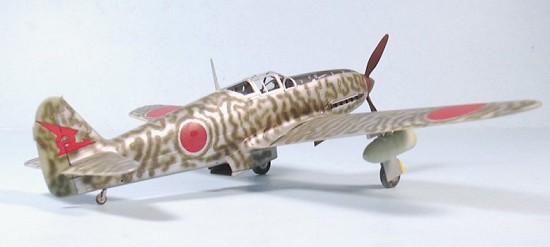 In August, 1943,
production switched to the Model 1A, in which the 12.7mm wing guns were
replaced by German 20mm Mauser cannon. Only 800 of these weapons were
obtained from Germany, limiting production of the Model 1A to 400 aircraft.
An interim production version, the Model 1B, replaced the previous armament
with 4 12.7mm weapons in both the fuselage and wings.
In August, 1943,
production switched to the Model 1A, in which the 12.7mm wing guns were
replaced by German 20mm Mauser cannon. Only 800 of these weapons were
obtained from Germany, limiting production of the Model 1A to 400 aircraft.
An interim production version, the Model 1B, replaced the previous armament
with 4 12.7mm weapons in both the fuselage and wings.
After fighting in New Guinea, the Ki.61 next appeared over Rabaul, followed by deployment to China, where it proved more than a match for the P‑40s of the 23rd Fighter Group. This in turn led to expedited equipment of the 23rd FG with the P‑51 Mustang in early 1944. The Ki.61 was also based in the Philippines in 1944.
Allied fighter pilots respected the Hien, which provided better armor protection for the pilot and engine than other Japanese fighter, while providing excellent maneuverability and a diving speed that allowed it to keep up with any Allied fighter that attempted to disengage by diving.
The appearance of the B‑29 in significant numbers over Japan, beginning in November 1944, led to the return of as many Ki.61‑equipped units to the Home Islands as possible. In limited combat against the China‑based B‑29s in the summer of 1944, the Ki.61 had proven to be one of the few Japanese fighters capable of meeting the B‑29 at altitudes over 30,000 feet. It equipped Japanese Taiatari (special attack) units, such as the 244th Sentai based outside Tokyo; its design allowed for ramming attacks against B‑29s that gave the pilot a good chance of a successful bailout just before impact.
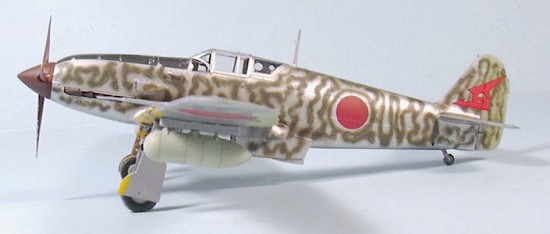 Unfortunately
for the Ki.61, the Ha.40 engine became an ever‑increasing source of
trouble, varying greatly in rated power between specific engines due to
poor production quality control. The designed‑in lightness of the engine
led to main‑bearing failures and oil system faults. By the Spring of 1944,
production of the Ki.61 was lagging due to the fact that production of the
Ha.40 had been cut back in an attempt to restore production quality.
Production of the engine stalled out completely in the summer of 1944 due
to a severe shortage of cylinder blocks and crankcases. Further development
of the Ki.61 in the Ki.61‑II and ‑III versions with a higher‑powered
development of the Ha.40 ‑ the Ha.140 ‑ were completely unsuccessful due to
the failure of the engine, though when the engine worked the Ki.61‑II was
the only Japanese interceptor capable of maintaining combat formation up to
33,000 feet.
Unfortunately
for the Ki.61, the Ha.40 engine became an ever‑increasing source of
trouble, varying greatly in rated power between specific engines due to
poor production quality control. The designed‑in lightness of the engine
led to main‑bearing failures and oil system faults. By the Spring of 1944,
production of the Ki.61 was lagging due to the fact that production of the
Ha.40 had been cut back in an attempt to restore production quality.
Production of the engine stalled out completely in the summer of 1944 due
to a severe shortage of cylinder blocks and crankcases. Further development
of the Ki.61 in the Ki.61‑II and ‑III versions with a higher‑powered
development of the Ha.40 ‑ the Ha.140 ‑ were completely unsuccessful due to
the failure of the engine, though when the engine worked the Ki.61‑II was
the only Japanese interceptor capable of maintaining combat formation up to
33,000 feet.
| THE KIT |
 To my mind, the Ki.61 Hien is the best‑looking Japanese fighter of
the Pacific War, with its narrow fuselage, pointed nose, and graceful
wings. Tamiya produced a 1/50 Ki.61 in the late 1960s, but this suffered
major fuselage outline irregularities due to the fact it was designed to
take an electric motor inside, which additionally meant that interior
cockpit detail was non‑existent. Otaki released a Ki.61-I in the early
1970s in 1/48 scale, which is accurate and still available, though it has a
bit more recessed surface detail ‑ in the form of rivets ‑ than one might
care for today, as well as a cockpit in need of detailing. Hasegawa first
released a Ki.61 in 1/72 scale in 1974. This was the first accurate kit of
this airplane released by any manufacturer, with very nice (for the time)
cockpit detail. This kit is still in production nearly 30 years later, and
can be safely recommended to any modeler who builds in the smaller scale.
To my mind, the Ki.61 Hien is the best‑looking Japanese fighter of
the Pacific War, with its narrow fuselage, pointed nose, and graceful
wings. Tamiya produced a 1/50 Ki.61 in the late 1960s, but this suffered
major fuselage outline irregularities due to the fact it was designed to
take an electric motor inside, which additionally meant that interior
cockpit detail was non‑existent. Otaki released a Ki.61-I in the early
1970s in 1/48 scale, which is accurate and still available, though it has a
bit more recessed surface detail ‑ in the form of rivets ‑ than one might
care for today, as well as a cockpit in need of detailing. Hasegawa first
released a Ki.61 in 1/72 scale in 1974. This was the first accurate kit of
this airplane released by any manufacturer, with very nice (for the time)
cockpit detail. This kit is still in production nearly 30 years later, and
can be safely recommended to any modeler who builds in the smaller scale.
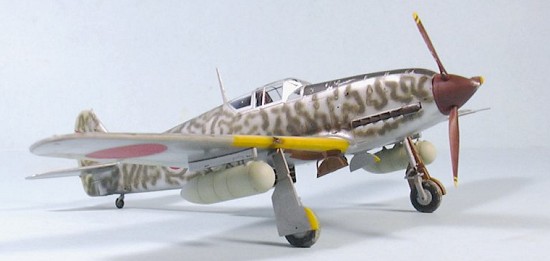 Hasegawa released
a 1/48 Ki.61-Ic in 1994. This kit of the Ki.61-I is that kit with a new
fuselage that incorporates the slightly-different shaped vertical fin and
the shorter nose of the early version. The kit also differs from the
earlier version by the inclusion of the smaller tailwheel and different
tail wheel well of the early version, as well as provision of theMG151
Mauser cannon and a larger breech fairing to allow a modeler to construct
the limited-production Ki.61-Ia version.
Hasegawa released
a 1/48 Ki.61-Ic in 1994. This kit of the Ki.61-I is that kit with a new
fuselage that incorporates the slightly-different shaped vertical fin and
the shorter nose of the early version. The kit also differs from the
earlier version by the inclusion of the smaller tailwheel and different
tail wheel well of the early version, as well as provision of theMG151
Mauser cannon and a larger breech fairing to allow a modeler to construct
the limited-production Ki.61-Ia version.
The kit is accurate, with thin trailing edges on all flying surfaces, and a cockpit that is detailed sufficiently out of the box that most modelers will not feel the need for a resin replacement. To my knowledge, only True Details ever made a resin cockpit for this kit, and it is now out of production. The one negative ‑ at least to me ‑ is that the canopy is one‑piece and cannot be displayed open. However, there is a Squadron vacuform canopy available for the Otaki kit that fits this kit with a bit of effort. By using the sliding section from this and cutting the kit‑supplied canopy apart, the model can be displayed with an open cockpit canopy.
The kit decals are superior to previous Hasegawa decals in both color and thinness, and provide markings for the well-known Ki.61-Ia flown by Captain Teruhiko Kobayashi of the 244th Sentai, an aircraft of the 56th Sentai and one from the 18th Sentai - both of these are in overall natural metal finish.
| CONSTRUCTION |
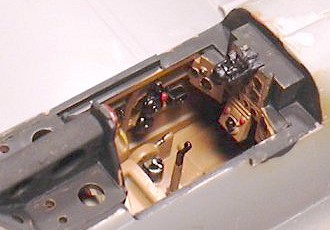 Construction is
extremely easy. I began by painting the parts for the cockpit interior,
the gear wells, and inside of the gear doors, with Gunze‑Sangyo RLM79 Sandy
Brown, a good substitute for the Kawasaki Tan used on the original. I
painted the various details, such as levers, etc., according to the color
diagram of a Ki.61 cockpit in Don Thorpe's "Imperial Japanese Army
Aircraft."
Construction is
extremely easy. I began by painting the parts for the cockpit interior,
the gear wells, and inside of the gear doors, with Gunze‑Sangyo RLM79 Sandy
Brown, a good substitute for the Kawasaki Tan used on the original. I
painted the various details, such as levers, etc., according to the color
diagram of a Ki.61 cockpit in Don Thorpe's "Imperial Japanese Army
Aircraft."
I then assembled the cockpit inside the fuselage, and proceeded to assemble the fuselage, then the wings. I only needed some Mr. Surfacer along the central fuselage seam; there were no gaps between the fuselage and wings, or the horizontal stabilizers.
| COLORS & MARKINGS |
Painting and Decals were a combined step on this model, due to the way it was painted.
The Ki.61 was delivered from the factory in two schemes: overall
green upper surfaces with natural metal lower surfaces and the fabric
covered control surfaces painted in Kawasaki Grey, and overall natural
metal with control surfaces in
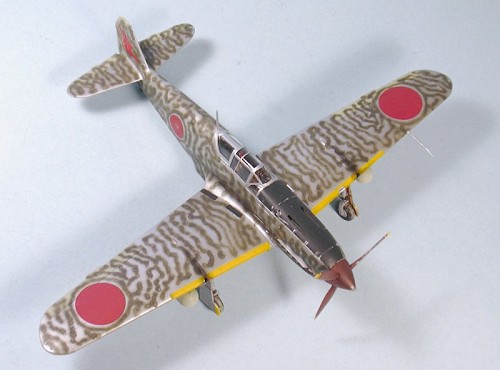 Kawasaki Grey; the
latter was the dominant scheme for the Ki.61‑I. Various camouflage schemes
were field‑applied on these NMF aircraft, and I chose to do one of the two
most‑common versions - a form of “wave mirror” pattern of dark green over
the upper surfaces, painted around the national insignia.
Kawasaki Grey; the
latter was the dominant scheme for the Ki.61‑I. Various camouflage schemes
were field‑applied on these NMF aircraft, and I chose to do one of the two
most‑common versions - a form of “wave mirror” pattern of dark green over
the upper surfaces, painted around the national insignia.
I first painted propeller and spinner, and the control surfaces with Tamiya “Japanese Army Grey,” which is pretty close to the Kawasaki Grey, the leading edge ID stripes with Tamiya flat yellow and the anti-glare area on the upper nose with Tamiya “NATO Black.” I then masked off those areas and shot the rest of the model with SnJ Aluminum. When that was dry, I masked off various areas of that color, and shot the remainder with Alclad II “Duralumin.”
I then unmasked the model and applied the Hinomarus. When that had set up, I put a coat of sealer over the decals, and then airbrushed the green “wave mirror” scheme around the markings, using Gunze Sangyo "IJA Green". This is not as hard as it sounds - just use a fine tip on the airbrush, and no more than 15 p.s.i from the air compressor, to limit "splash."
When the camouflage was dry, I applied the kit marking for the 54th Sentai on the vertical fin.
| FINAL CONSTRUCTION |
I applied a light coat of Dullcote to the decals and blotched it over the upper surfaces since the aluminum would have gone flat over time in a Pacific island environment. I used Tamiya “Smoke” for the exhaust and gun stains. When that was complete, I unmasked the canopy and attached the landing gear and prop.
| CONCLUSIONS |
Like I say, the Ki.61 is a beautiful airplane, and this Hasegawa kit does it full justice, built "out of the box."
March 2005
Review Kit courtesy of HobbyLink Japan www.hlj.com .
If you would like your product reviewed fairly and quickly by a site that has nearly 300,000 visitors a month, please contact me or see other details in the Note to Contributors.